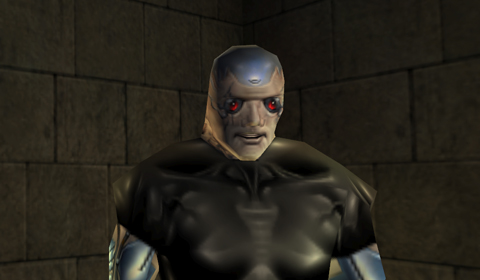
CHOICE
Games are purely by nature an interactive experience. Input from a user is required to keep the flow of events going. Naturally, there are degrees to distinguish. On one side, there are games that deliver a similar, if not identical experience on each and every playthrough. This enforces the idea that the player has little influence in the grand scheme of things (thus implying a low degree of interactivity). An example is the Call of Duty series. On the other side are games that factor a significant level of redundancy into their design, so that the player has to make choices about what to experience. In practical terms, this means such games often offer a choice between two (or more) different paths. This can range from choosing an approach to gameplay (action or stealth) over character development using skill points to dialogue trees during conversations. When the word 'choice' is thrown around in terms of gameplay mechanics, players generally assume overt choices between two extremes (more often than not, between right and wrong). The game in fact takes a moment to announce to the player that a choice will have to be made. This can range from picking a certain dialogue option to choosing whether or not to kill a major character. Sometimes, such choices feed into a morality gauge, creating a character that's either righteous or evil. In this respect, choice has become a valuable marketing tool for certain games, going so far as telling players they can 'create their own experience'. But what is often overlooked is that choice is already an inherent aspect of games, though less exposed and on a more basic level. An obvious example lies in the weapon the player chooses to deal with a certain enemy (or more abstractly, the tool he uses to deal with a given situation). Does he choose a pistol or a rocket launcher? This is a gameplay choice, one as valid and as persistent as the type of choice mentioned in the paragraph above. Now we can also apply this basic level of choice to the story of a game. I believe that the most successful games are those that have stories that are as deep as the player chooses them to be. Looking beyond the simple decision of whether or not to skip a cutscene, I’m more referring to the practice of adding content to the game world that is optional to the player, but adds a layer to the overarching narrative that enhances it. Deus Ex is a wonderful example of this practice, littering its game world with datacubes, terminals, newspaper articles and even character interactions that are not essential to progression, but freely available to the player to explore at their own pace. More often than not, such content allows players to glean more information about the world in which they’re operating and the characters that inhabit it. Another way to enhance the story of a game is to introduce side stories that do not necessarily relate to the player’s story arc. The most recent example I can think of is Sadie’s Story, a secondary narrative threaded into the main story of Halo 3: ODST. Players piece together the flow of events by collecting audio logs scattered throughout the game world. Thusly, the plight of one of New Mombasa’s citizens during the Covenant invasion is told, but it is not considered as imperative knowledge to the main story. Instead, it enhances the overall experience. Yet another way recently occurred to me when reading this post over at The Escapist. It details how most game levels are effectively over once the player has finished his mission in it. We hardly ever hear what happens in the aftermath, negating any feeling of agency the player might experience because there were little to no consequences to his actions. But such a thing does not require much work. I refer to a small but effective example from Deus Ex, where a mission has its protagonist (JC Denton) infiltrating the headquarters of a pharmaceutical company in Hong Kong. Long after this mission is completed, the player may come across a datacube where this mission is referenced. Apparently, JC’s actions have upset his adversaries to the point where they had the building destroyed, killing 35 people in the process so the act could be masked as a terrorist attack. In effect, the player’s actions led directly to this loss of life. In this case, and all others, the devil is in the details.CHARACTERS
The article I linked to in the paragraph above also mentions how an ordinary NPC can be humanized by mere words, which can completely alter a given player’s approach. Again, I refer to Deus Ex for an example. JC Denton has a formidable foe in his former colleague, Gunther Hermann, a biomechanically augmented agent. Hermann has made it his mission to seek out and kill JC, because the former’s partner was killed by the latter (which is, incidentally, the only NPC that has to be killed in order to progress the game). Once again, a single datacube brings so much more to the character of Hermann. The datacube contains the diary of a guard who detailed Hermann’s behavior, which included him standing guard for 10 hours, unmoving, and apparently crying at one point. It almost made me want to save him. If a single NPC can be humanized with such sparse means, what of the protagonist? I’m taking a page from one of Anthony Burch’ rants (available here). He makes a distinction between Mirror’s Edge and Half-Life 2 pertaining to character empathy. When we want to create a character that the player cares about or at least can relate to, this character needs to be empathetic (something Robert McKee emphasizes in his seminal screenwriting book Story). This means the player wants the character to achieve whatever it is he or she desires. This is no easy task, and in games this is made more daunting by the fact that the player is the protagonist and views the world through their eyes. In Mirror’s Edge, the primary motivation for many of the protagonist's (Faith) actions is her sister’s plight. But because the two share a history that the player is only indirectly aware of (largely through animated cutscenes), it’s difficult to create a connection. This is best evidenced by a piece of dialog that occurs after Faith hijacks a prison transport to save her sister. When asked why she did what she did, Faith simply replies deadpan: "You’re my sister". On the other hand, the narrative backdrop of Half-Life 2 allows its protagonist, Gordon Freeman, to meet Alyx at the same time the player does, which creates a stronger bond than can be exemplified by a single statement or piece of dialogue. I’m not saying either is a preferable approach. The point is that there are many more ways to create empathetic bonds between characters beyond the obvious ones.
She\'s either really determined or in dire need of a toilet break.
Comments
Add new comment